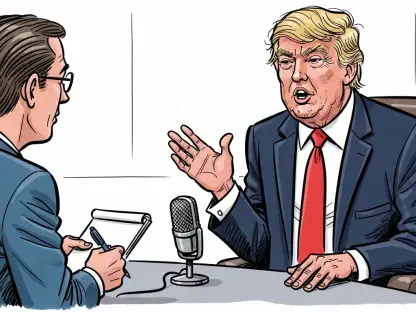Realism has become a defining characteristic in the arena of U.S. foreign aid, steered by the calculated measures of the Trump administration. Historically, American foreign aid was portrayed as a moral commitment to global welfare, forming a bridge of support to communities worldwide. Under Trump, however, foreign aid is re-envisioned, unapologetically linked to reinforcing U.S. geopolitical strength and national interests. This represents a seismic shift from the country’s previous humanitarian-driven strategies, as aid is now perceived as a vehicle to fortify U.S. influence globally. Secretary of State Marco Rubio actively champions this realist approach, illustrating a departure from tradition.
The Shift Towards Strategic Realism
Foreign Aid: A Mechanism of Power
The Trump administration staunchly prioritizes foreign aid as a means to enhance U.S. geopolitical power. This approach reconfigures the motivational compass of foreign assistance to strategically favor American interests. In articulating this transformation, Secretary of State Marco Rubio underscores that aid is an instrument of national self-interest rather than goodwill. By viewing foreign aid through the lens of strategic advantage, discussions have pivoted from ideals of charity to considerations of power dynamics and influence. This repositioning suggests a broader strategic agenda where aid is aligned with national security and foreign policy objectives.
Foreign aid transitions from a seemingly benevolent gesture to a carefully calculated element of a grand strategy. By employing aid in this manner, the administration aims to strengthen global alliances, garner favor, and counter rivals. The realignment underlines a trajectory that foregrounds American power as the critical currency in international relations. Such an approach encourages holding allies accountable while reaping tangible benefits. This rhetoric effectively diminishes the purely altruistic narrative traditionally associated with U.S. international aid, driving foreign policy through explicitly realist lenses.
Redefining Objectives
Trump’s presidency dismantled the humanitarian façade previously attached to foreign aid, ushering in a dialogue focused primarily on realist motives. By doing so, it has fostered debates among policymakers who question the essence and objectives of U.S. assistance. Critics see the administration’s stance as a reduction of noble causes to pragmatic pursuits, inviting contentious discussions over the ethical implications. The refashioning of foreign aid calls into question the sustainability of morality-bound policies when faced with tangible national interests.
While Trump’s realism resonates with some, it inevitably collides with those holding expectations of aid as an emblem of American benevolence. Detractors see this shift as a betrayal of ethical responsibilities towards global equity, overlooking critical humanitarian concerns. By diverging from traditional policy paths, this strategic realignment challenges the fundamental premise that foreign aid should address basic human needs irrespective of political gain. Consequently, the evolving discourse underscores a broader ideological clash over the utility and purpose of aid amid complex geopolitical landscapes.
Policy Debates and Public Perspectives
Divided Opinions
Public sentiment and expert analysis reveal a stark divide over the Trump administration’s perceived commercialization of foreign aid. Realists champion the notion that aid should serve as a geopolitical tool, reinforcing national security and addressing economic interests. Conversely, liberals perceive aid as a moral imperative, voicing concerns about potentially compromising the spirit of altruism. This bifurcation in perspectives mirrors an enduring tension between pragmatism and idealism in U.S. policy.
The Trump administration’s prioritization of strategic objectives in foreign aid invites scrutiny over the ethical ramifications of aid distribution. Within this contentious terrain, policymakers and public voices grapple with defining the true compass of America’s global engagements. Realists see the recalibration as necessary to maintain U.S. dominance and security, while idealists fear a loss of American identity rooted in moral conviction. This ideological rift presents policymakers with a formidable challenge of striking a balance between duty and strategy.
Realism’s Consolidation in Washington
In the heart of Washington, realism’s influence decisively shapes the discourse surrounding foreign aid, with policymakers increasingly embracing this pragmatic outlook. The administration’s strategies underscore a perception of aid recipients as vehicles for strategic advantage, rather than beneficiaries. Such a view aligns with broader geopolitical calculations made in response to global power dynamics, invoking the themes of competition and leverage.
Positioning foreign aid within the utilitarian framework, the Trump administration narrows the scope of aid initiatives, drawing focus on direct returns to U.S. interests. These strategies reflect an evolving calculus where global relationships are evaluated based on reciprocal benefits. Responsibilities are shifted towards pragmatic, security-first policies, consolidating realism as a predominant force in crafting contemporary U.S. foreign aid narratives. By recalibrating the focus of international support, Washington’s embrace of realism marks a momentous realignment, reinforcing national prerogatives and shaping the world stage accordingly.
Practical Applications of Realism
Strategic Alignment with National Security
Strategic realism governs the Trump administration’s approach to foreign aid, ensuring alignment with national security interests and broader U.S. policy goals. The administration advocates for the deployment of aid as a means to empower allies and counter external threats. This tactical orientation promises to deliver returns that directly enhance American geopolitical standing, marking a calculated divergence from previous, ideologically motivated practices.
Through leveraging aid to strengthen partnerships and foster cooperation, the administration emphasizes benefits that serve America’s strategic objectives. Recognizing that global partnerships translate into political leverage and security assurances, aid is utilized as a crucial tool for U.S. influence. In this context, the allocation of aid demands prudent consideration, ensuring it complements U.S. ambitions within dynamic global spheres dictated by power politics. The administration’s focus on meticulously aligning foreign assistance with broader security agendas elevates strategic realism as an operative principle guiding foreign policy debates.
Skepticism and Utility
Despite skepticism about the effectiveness of foreign aid in transforming societies, the Trump administration acknowledges its potential utility when aligned with U.S. interests. Diplomats like James Jeffrey highlight scenarios where foreign assistance plays critical roles, such as stabilizing displaced populations in conflict zones like Syria. The administration’s realist perspective is not blind to aid’s functional advantages, acknowledging its pragmatic value in select circumstances where it reciprocates security interests.
The skepticism towards unbounded humanitarian endeavors is balanced by an understanding of aid’s instrumental uses, especially in addressing crises with potential repercussions for American safety. Within the administration’s policies, the effectiveness of aid is judged not on transformative promises but rather on its capacity to stabilize regions and support strategic allies. This nuanced stance carefully weighs aid’s capacity to support broader U.S. objectives without succumbing to oversimplified agendas of altruism, ultimately reaffirming realism as a guiding framework for U.S. foreign interventions.
Nuances Within Realist Foreign Aid
Balancing Idealism and Realism
The dominance of realism within the Trump administration’s foreign aid strategy does not wholly eclipse elements of idealism, particularly within programs like PEPFAR. These initiatives hint at a persistent, albeit nuanced, commitment to humanitarian concerns, demonstrating that strategic interests can coexist with altruistic objectives. The realism-idealism dichotomy reflects an intricate balance where aid supports broader security narratives while sustaining beneficial humanitarian measures.
Acknowledging the broader spectrum of foreign aid, the administration recognizes the importance of such programs in addressing public health emergencies with global ramifications. Elements of idealism sometimes supplement strategic decision-making, underlying the nuanced policy structure that accommodates targeted aid interventions. While realism takes precedence, these actions serve as testament to the ongoing evolution of foreign aid priorities, highlighting opportunities to address critical humanitarian crises when they align with strategic goals.
Humanitarian Initiatives with Strategic Purposes
In instances like addressing global health crises such as Ebola, the Trump administration demonstrates how humanitarian initiatives can be aligned with national security aims. This alignment defines a strategic landscape where assistance is not merely reactive but serves proactive purposes addressing potential threats on home soil. Acknowledging the intrinsic humanitarian value of combating pandemics, the administration channels international health aid into broader security narratives.
Such initiatives show how foreign aid, underlined by strategic realism, addresses crises with substantial international implications while adhering to U.S. interests. Realism’s pragmatic approach does not dismiss idealism outright but selectively incorporates it when it coalesces with national security imperatives. This nuanced commitment elucidates realism’s potential to refine foreign aid policy, emphasizing that humanitarian efforts can be framed within strategic contexts to advance tangible, mutual benefits.
Realism and Rhetoric
The Cold Logic of Realism
Under the Trump administration, foreign aid rhetoric reflects a distinct focus on enhancing U.S. power through strategic utility. The administration unapologetically classifies aid recipients as instruments in the pursuit of geopolitical advantage, prioritizing national interests over external goodwill. This pragmatic reevaluation aligns with Trump’s broader strategic objectives, ensuring that aid programs enhance economic gains and security outcomes for the United States.
These policies reflect a broader pursuit of power where aid is scrutinized and deployed with evident strategic intent. The administration’s rhetoric mirrors realism’s principles, advancing an agenda that equates aid dollars with measurable returns to the nation’s standing. As such, the shift towards realism signifies a departure from previous narratives centered around altruism and moral duties, setting the stage for a recalibrated foreign policy landscape where calculated actions supplant benevolent intentions.
Policy Evolution
The concept of realism has taken center stage in the U.S. foreign aid strategy, particularly during the tenure of the Trump administration. Traditionally, American foreign aid had been framed as an ethical obligation to assist globally, serving as a nurturing channel for communities across the world. However, under Trump’s leadership, this aid has undergone a significant transformation. It now unabashedly aligns with bolstering U.S. geopolitical power and securing national interests. This marks a dramatic departure from the country’s previous humanitarian-focused tactics, as foreign aid is now viewed as a strategic tool to expand U.S. global influence. Secretary of State Marco Rubio has been a vocal advocate for this realist approach, signaling a clear break from earlier practices. His endorsement showcases a pivot from idealistic to pragmatic policies, underscoring a commitment to using aid as a means of enhancing U.S. dominance on the international stage, thereby strengthening national security and economic objectives.









